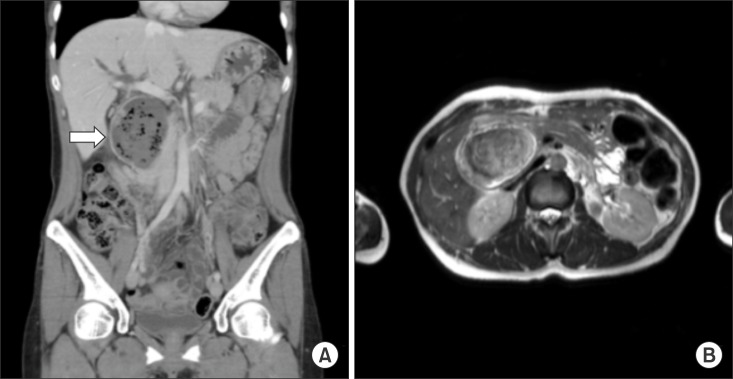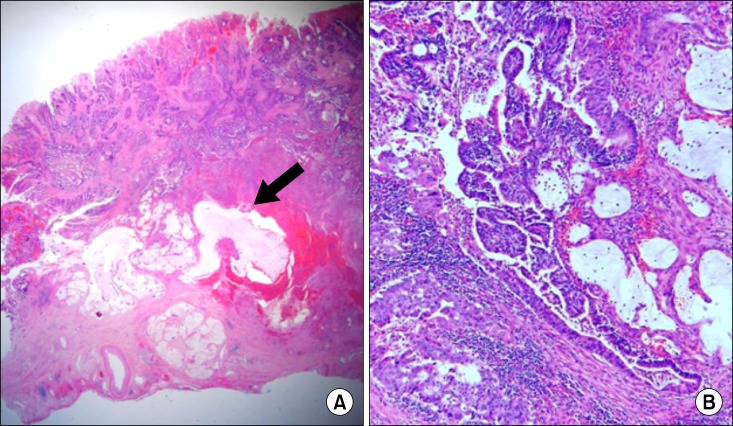Ann Hepatobiliary Pancreat Surg.
2016 Nov;20(4):201-203. 10.14701/ahbps.2016.20.4.201.
Cholangiocarcinoma in choledochal cyst after cystoenterostomy: how a mistreated choledochal cyst can progress to malignancy
- Affiliations
-
- 1Department of Surgery, Busan Paik Hospital, College of Medicine, Inje University, Busan, Korea. changmd2000@naver.com
- KMID: 2362472
- DOI: http://doi.org/10.14701/ahbps.2016.20.4.201
Abstract
- This case report presents an unusual case of cholangiocarcinoma arising nearly 35 years after cystoduodenostomy for choledochal cyst. The patient visited our hospital with dyspepsia and studies revealed bezoar within the choledochal cyst caused by bile and food reflux. The patient underwent pancreaticoduodenectomy and a biopsy revealed adenocarcinoma, stage IIB. After 19 months, the patient has no recurrence to date and has recovered well. This case shows that proper surgical management and meticulous, long-term follow-up is imperative for patients with congenital choledochal cyst.
MeSH Terms
Figure
Reference
-
1. Khandelwal C, Anand U, Kumar B, Priyadarshi RN. Diagnosis and management of choledochal cysts. Indian J Surg. 2012; 74:401–406. PMID: 24082594.
Article2. Sallahu F, Hasani A, Limani D, Shabani S, Beka F, Zatriqi S, et al. Choledochal cyst - presentation and treatment in an adult. Acta Inform Med. 2013; 21:138–139. PMID: 24058256.
Article3. Kim SH, Kim HW, Kang DH, Kim MD, Lee JH, Lee JH, et al. A case of intrahepatic cholangiocarcinoma associated with type iv choledochal cyst. Korean J Gastroenterol. 2012; 60:123–127. PMID: 22926125.
Article4. Franko J, Nussbaum ML, Morris JB. Choledochal cyst cholangiocarcinoma arising from adenoma: case report and a review of the literature. Curr Surg. 2006; 63:281–284. PMID: 16843781.
Article5. Ohashi T, Wakai T, Kubota M, Matsuda Y, Arai Y, Ohyama T, et al. Risk of subsequent biliary malignancy in patients undergoing cyst excision for congenital choledochal cysts. J Gastroenterol Hepatol. 2013; 28:243–247. PMID: 22989043.
Article6. Lee SE, Jang JY, Lee YJ, Choi DW, Lee WJ, Cho BH, et al. Choledochal cyst and associated malignant tumors in adults: a multicenter survey in South Korea. Arch Surg. 2011; 146:1178–1184. PMID: 22006877.7. Ong J, Campbell W, Taylor MA. Metastatic cholangiocarcinoma following choledochal cyst excision: an unusual cause of abdominal pain in a 35-year-old female. Ulster Med J. 2013; 82:21–22. PMID: 23620626.
- Full Text Links
- Actions
-
Cited
- CITED
-
- Close
- Share
- Similar articles
-
- A Choledochal Cyst Combined with a Hilar Cholangiocarcinoma
- A case of type IVa choledochal cyst
- A Case of Cholangiocarcinoma Arising from Type I Choledochal Cyst in a 13-year-old Girl
- Development of Cholangiocarcinoma Arising from Remnant Intrapancreatic Cyst 15 Years after Choledochal Cyst Excision
- Type IVB Choledochal Cyst : A case report



